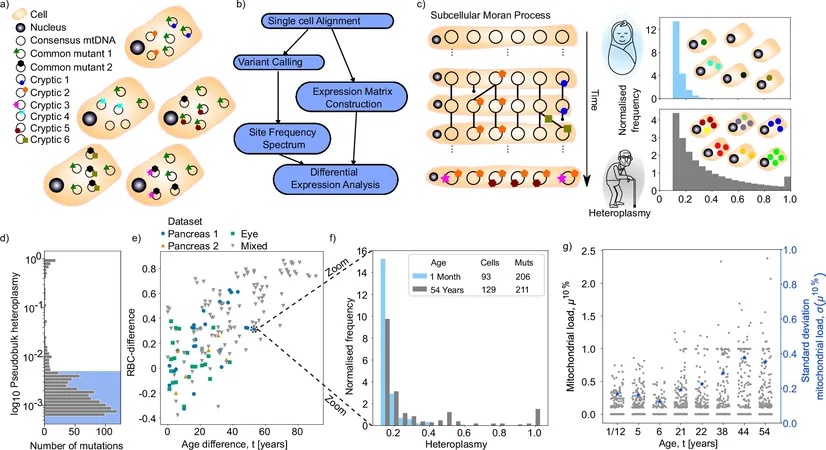
Unraveling the Secrets of Aging: How Hidden Mitochondrial DNA Mutations Could Hold the Key
2025-05-28
Author: Ming
Groundbreaking Research Reveals Hidden Mutations in Aging
A recent study published in *Nature Communications* has unveiled a fascinating connection between hidden mutations in mitochondrial DNA and the aging process, suggesting that the accumulation of these mutations may serve as a significant marker for age-related decline.
Mitochondria, often dubbed the powerhouse of the cell, possess their own full sets of genetic material or genomes. Each cell can contain thousands of these mitochondrial genomes, making them critical players in cellular function.
The Power of Sequencing Technology
Thanks to cutting-edge advancements in sequencing technology, researchers can now delve deep into the genomes of both mitochondria and the nucleus at the individual cell level. This capability has led to the discovery of cryptic mutations—those hidden anomalies detectable in only a single cell within a tissue sample.
Insights from the Experts
We had the privilege of interviewing Professor Nick Jones and Dr. Alistair Green from Imperial College London’s Department of Mathematics about their compelling work on mitochondrial mutations and their implications for aging.
Professor Jones shared, "We discovered that the levels of these cryptic mitochondrial mutations predict key gene expression patterns tied to aging. Most intriguingly, the increase in mutations aligns with the onset of aging characteristics in humans."
The Nonlinear Journey of Aging
One fascinating aspect of their findings is the non-linear nature of aging. Unlike nuclear DNA, which accumulates mutations steadily, mitochondrial mutations spike unexpectedly, coinciding with physiological decline. This raises intriguing questions about the underlying mechanisms of aging and the role of mitochondria.
Why Mitochondria?
Dr. Green explained the rationale behind focusing on mitochondria: "As the energy producers of the cell, mitochondria are essential to our overall health. Mitochondrial diseases illustrate the severe impact mutations can have across bodily systems. Moreover, experiments on mice have shown that higher mitochondrial mutation rates accelerate the appearance of aging traits quickly."
A Breakthrough in Discovery
The researchers have likened their findings to uncovering 'mutational dark matter.' These cryptic mutations often go unnoticed without advanced single-cell sequencing technology, which has only recently become viable.
Cautions and Correlations
While their results point to correlations between mitochondrial mutations and aging, the team is cautious. Jones notes, "Our findings are correlative, not causal. While the data suggests a link between high levels of mitochondrial mutations and the expression of aging-related genes, we cannot assert causality without further research. However, existing studies that directly manipulate mitochondrial genomes support our hypotheses."
A New Perspective on Aging
Instead of attributing aging to a specific mutation, the researchers propose that it may be the diverse mix of mutations across cells that may influence the aging process. This perspective opens up exciting avenues for future research on how these hidden mitochondrial mutations might be targeted for therapeutic interventions.
As science peeks further into the cryptic layers of our biology, these discoveries could pave the way for groundbreaking advancements in our understanding of aging and longevity.

 Brasil (PT)
Brasil (PT)
 Canada (EN)
Canada (EN)
 Chile (ES)
Chile (ES)
 Česko (CS)
Česko (CS)
 대한민국 (KO)
대한민국 (KO)
 España (ES)
España (ES)
 France (FR)
France (FR)
 Hong Kong (EN)
Hong Kong (EN)
 Italia (IT)
Italia (IT)
 日本 (JA)
日本 (JA)
 Magyarország (HU)
Magyarország (HU)
 Norge (NO)
Norge (NO)
 Polska (PL)
Polska (PL)
 Schweiz (DE)
Schweiz (DE)
 Singapore (EN)
Singapore (EN)
 Sverige (SV)
Sverige (SV)
 Suomi (FI)
Suomi (FI)
 Türkiye (TR)
Türkiye (TR)
 الإمارات العربية المتحدة (AR)
الإمارات العربية المتحدة (AR)